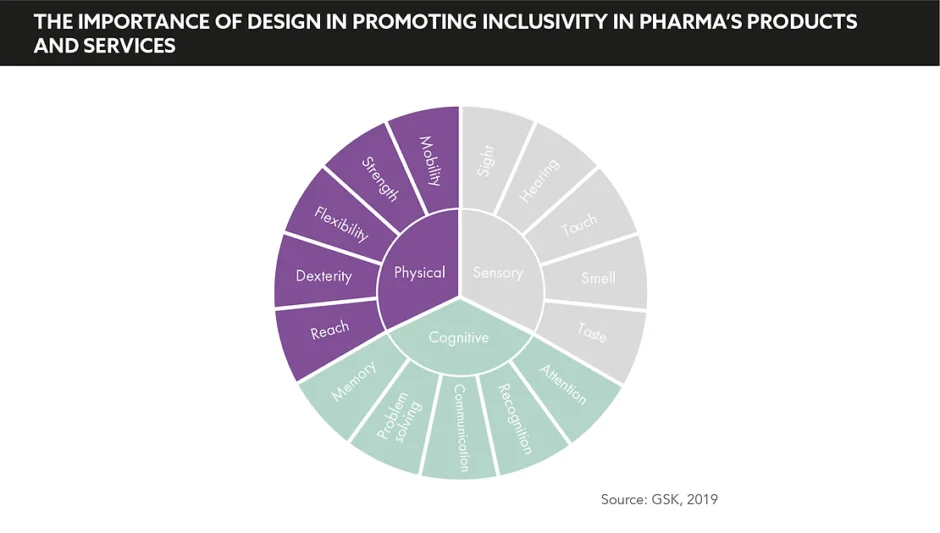Words by James Coker
“The last 10 years have seen enormous growth within the design industry. We now have UX, UI, and service design. And all of that culminates in what I would call experience design”, comments Andrew Barraclough, Vice President of Global Design and Innovation, GSK, at Cannes Lions.
This recent elevation of design across numerous sectors is heavily linked to the growing recognition that enhancing user experience (UX) with brands is crucial: a principle that applies very much to the pharmaceutical sector. This department must see a transformation in pharma, from an afterthought hidden from sight in the dusty back-offices to being the beating heart of the company. It is now up to design to show they are ready to step up and take on these new responsibilities.
“Design was at the back-end of the process, with an attitude of ‘hand it over to the design guys at the end, they’ll make it look nice’. It was never at the front end of the process, never solving difficult business problems, never really brand building”, says Barraclough.
Yet with increasing digitalisation comes the opportunity for customers to more easily engage with brands, and therefore a need to create more meaningful UX. Usability, accessibility, and desirability of a brand are heavily intertwined with design, be it on a website, in advertising, or packaging of a medicine. “UX is a process of enhancing user satisfaction and their interaction with the product”, explains Agata Cieslar, UX Lead & Innovation Champion, Roche. “UX design defines the sequence of interactions between a user and a system or a process; virtual or physical design to meet and support user needs. It’s also to satisfy unique system requirements and organisation objectives.”
Without data we are in darkness. If you don’t know the context and you haven’t done enough user research, you are lost
But how can design be empowered to take on such a wide-ranging function? Ensuring their fabric is interwoven with all aspects of an organisation is critical. “At GSK, design sits in the heart of our organisation, it’s not some different department in the basement nominally, it sits there with marketing embedded in the brand team. Brand building is a team sport and design is a key partner to marketing, not only with our external agencies but with all our internal departments as well, acting as creative steward and council in building a connected experience”, outlines Barraclough.
Designers need to have a different mindset. They need to get outside of their traditional thought that design is about making something look nice
In Barraclough’s view, designers must adopt a whole new mindset, grabbing the broader remit they can have with both hands. “The fact that [design] is a little bit of everything gives it permission to cut across all of those silos and different departments. But designers need to have a different mindset; they need to get outside of their traditional thought that design is about making something look nice; it’s beyond that”, he adds.
To be successful in developing UX, as well as frontline service, design must also be adept at staying back in HQ, gathering intelligence to plan tactics. This is firstly in an internal capacity, understanding the needs and motives of the organisation they are working for. “UX design is a constant iteration. You work as a part of the business, finding the answers: why you are doing this product, what KPIs should it cover?”, says Cieslar.
Even more crucially, design must establish a deep-rooted knowledge of their customers prior to any practical design work. Cieslar adds: “There’s a myth that we have skills to create nice, easy, and user-friendly interfaces without any effort. It requires a lot more work on the context, gathering insights and feedback in order to create successful products. Without data we are in darkness. If you don’t know the context and you haven’t done enough user research, you are lost.”
For Iain Tait, ECD, Weiden + Kennedy, it is most important to understand what the feel of a brand is to a user to enhance their experience, above appearances. “Moving forward, we all have to start thinking about how things feel when you’re touching it and moving things around. And it’s about how things feel for your heart and your mind”, he says.
In an era when UX is becoming fundamental to businesses globally, the role of design teams is taking on a whole new meaning. In pharma, it is important that design is empowered to fulfil a huge variety of functions for UX to be at its optimum. This requires detailed knowledge, both internally and, of course, of the users themselves and the way they interact with a brand. Fundamentally, it is about design realising their vast potential and moving themselves firmly into the spotlight.







